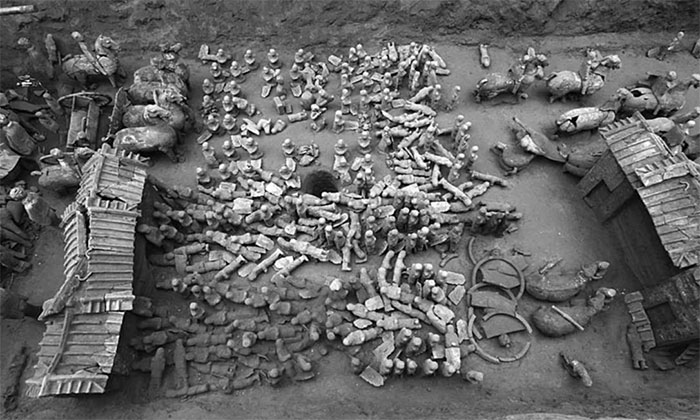Discovered the terracotta army protecting the tomb of Han's son
Terracotta army consisting of hundreds of warriors defends Liu Hoanh, the second son of Han Wudang, excavated in Shandong Province, China.
Archaeologists found tiny terracotta troops in the grave in an ancient crater in China, consisting of carefully arranged chariots and statues of cavalry, infantry, musicians and watchtowers. The soldier's statue looks exactly like the miniature version of the Terracotta Army defending the tomb of Qin Shihuang, the first Chinese emperor, Live Science reported yesterday.

Tiny terracotta army excavated in Shandong Province.(Photo: Chinese Cultural Heritage Magazine).
Based on the design of the artifacts found, the archaeological group thinks that the burial pit was dug around 2,100 years ago, about a century after the Terracotta Army was born. The southern part of the crater contains the cavalry head and the carriage, along with the 140cm high watchtower model. At the center of the crater, about 300 infantrymen stand guard according to the square layout. The northern part of the crater has a theater model with a small musician statue.
"The shape and scale of the crater indicates that this is a construction with a large burial site. Vehicles, cavalry and births arranged in squares for burial of kings, gods or princes" , archaeologists said.
The soldiers in the newly discovered army are much smaller than the Terracotta Army. Based on chronology, size and location of the burial site, archaeologists believe that this army was built for Qi Huaiyan Liu Hoanh , the second son of Han Wu De (reigning in 141 - 87 BC ).
Liu Hoanh lives in the Chinese capital of Qi, now north of Linzi in Shandong Province, China. He died in 110 BC."According to historical records, Liu Hoanh was conquered as a king of the Qi Dynasty at a young age but he unfortunately died early without a descendant. Soon after Liu Hoanh died, a comet appeared in the sky. China according to ancient historians Ban ".
If the burial pit and terracotta army used to protect Liu Hoanh or another royal member in the afterlife, there must be a grave nearby. The elderly in the area once described a recognizable mound about 4 meters high near the burial site. In the 1960s and 1970s, workers leveled the mound to expand the Giao Nam - Jinan railway.
is the only known example of real-sized soldiers. After Qin Shihuang died in 210 BC, the Qin Dynasty also quickly collapsed, giving way to the Han Dynasty.
Some Han emperors continued to build burial pits with terracotta troops to bury them when they died, but the soldiers were much smaller. For example, the unearthed infantry statue at Lam Truy is only 22 - 31 cm tall. The burial pit was discovered in the winter of 2007 during construction. After the excavation ended, archaeologists at the Linzi County Cultural Heritage Office in Zibo City were analyzing the artifacts and research team from the Shandong Province Cultural and Archaeological Heritage Institute. .
- New discovery of terracotta army in the tomb of Qin Shihuang
- The sophisticated weapon of the terracotta army in the tomb of Qin Shihuang
- The deadly weapon of the terracotta army, the tomb of Qin Shi Huang
- New theory about terracotta army Qin Shihuang
- Video: The army escorts Qin Shihuang to death
- Artists build terracotta army Qin Shihuang used to eat dog meat
- Video: Qin Shihuang's process of making terracotta army
- The Greeks built an army to guard the tomb of Qin Shihuang
- Discovering foreign soldiers in the tomb of Qin Shihuang
- The mystery of the tomb Qin Shihuang
- Excavating the tomb of Qin Shui Huang, discovering the animal world inside
- Why hasn't China dared to excavate the tomb of Qin Shui Huang?
 Discovered an ancient centipede fossil 99 million years old
Discovered an ancient centipede fossil 99 million years old Discovered bat-like dinosaurs in China
Discovered bat-like dinosaurs in China Discovered a 200-year-old bronze cannon of the coast
Discovered a 200-year-old bronze cannon of the coast Discover 305 million-year-old spider fossils
Discover 305 million-year-old spider fossils